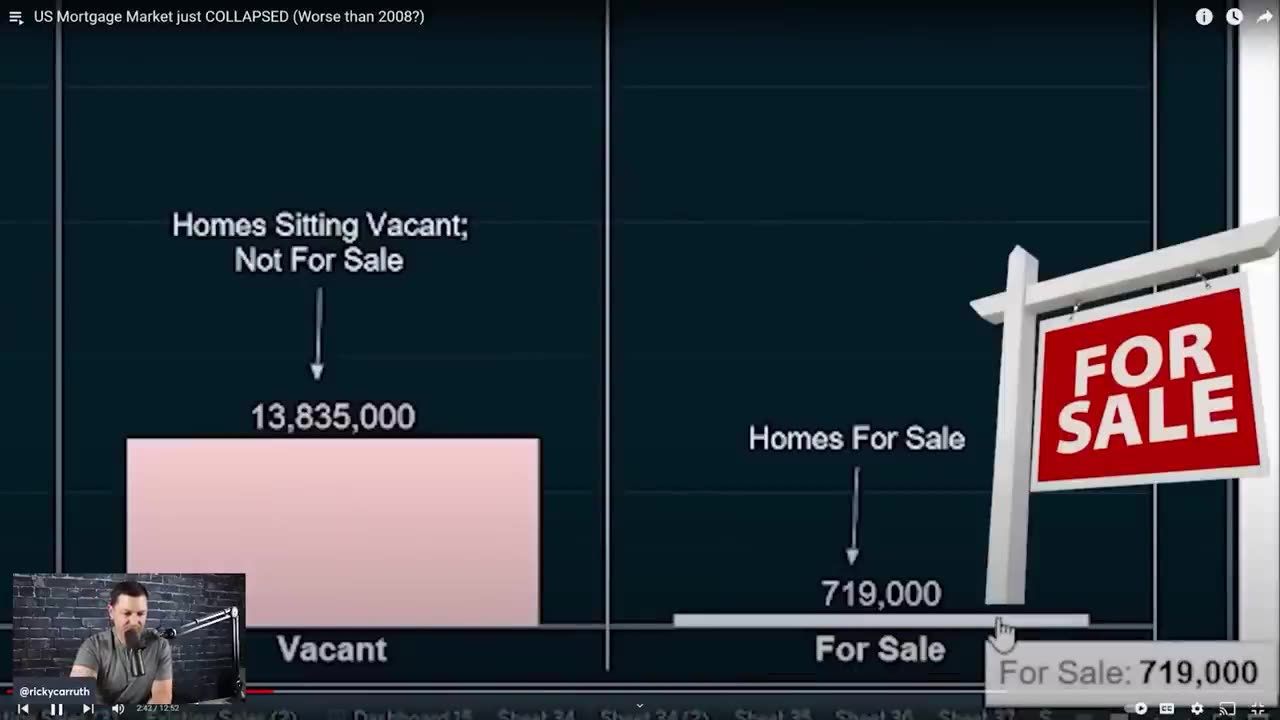Premium Only Content

Why Home Mortgage Rates Are High Relative To Treasuries—And When They Will Fall
The interest rate on home mortgages is running much higher than usual relative to the interest rate on long-term treasury bonds. Mortgage industry professionals wonder if the spread will return to normal—meaning lower mortgage rates so long as treasury interest rates remain stable. That will probably happen, but not in 2023.
The spread is wide by historical standards. Before the pandemic, the average spread over all available data was 1.69 percentage points. February 2019, for example, 10-year treasury bonds paid 2.68% interest. The average 30-year fixed rate mortgage cost the homeowner 4.37%, The difference was right at the long-term average of 1.69%. Most of the time the spread ranges between 1.5% and 2.0%.
The home buyer goes to a mortgage originator—usually a mortgage broker or bank—who quotes an interest rate. Then the originator sells the loan, usually to a government sponsored entity such as Fannie Mae or Freddie Mac. Like any middleman, the mortgage originator is paid for this service. The originator is paid a cash equivalent to the value of pushing the interest rate up. The first week of 2020, for example, the average mortgage interest rate was 3.72%. Fannie Mae’s average interest rate paid to investors was 2.61%. What happened to the difference between those two rates, the 1.11% spread? That paid the mortgage originator for his services. That payment can be thought of as the retail mortgage spread.
When Fannie or Freddie sells a bundle of mortgages to investors, the interest rate is based on supply and demand, of course. Investors generally think mortgages are inferior products compared to treasury bonds. Although both are deemed safe, the U.S. treasury will keep paying interest for the term of the bond. But homeowners have the option to refinance when mortgage rates drop. The option to refinance means that when interest rates drop, homeowners refinance. The investors no longer own an old mortgage with a high interest rate. Instead, investors now have cash that they have to reinvest at the new, low interest rates. Investors don’t like this.
When interest rates are rising, investors also have a problem. They are stuck with old, low-interest mortgages that nobody will pay off early. They would like to get their cash back and buy some of the new, high-interest mortgages, but that’s not happening.
The option for homeowners to refinance their mortgages makes mortgage-backed securities an inferior investment option. So investors will buy them only if they offer a premium over treasury bond interest rates. That is the wholesale mortgage spread.
At any moment in time, the total spread is the sum of the retail spread and the wholesale spread. The total spread widened a good bit in the first half of 2020, when the Federal Reserve was pushing interest rates down while the government sent out stimulus checks. Homeowners refinanced their mortgages to take advantage of the lower interest rates. Apartment dwellers started shopping for homes, enabled by cash in their bank accounts plus low mortgage rates. The mortgage originators were swamped with business. They could not handle all of the mortgage refinancings that the public wanted, at least not right away. While they were adding staff and training the new hires, they boosted their profit margins. The retail spread rose a great deal, and the wholesale spread just a little. This was documented by William Emmons of the Federal Reserve Bank of St. Louis.
The wide total spread between mortgage rates and treasury bonds in early 2023 seems to be due to the wholesale level. Bond traders cite volatility of interest rates as the key factor. Remember that rising interest rates mean that mortgage-backed security owners receive few prepayments they most want them. Falling interest rates mean that mortgage-backed securities owners receive most prepayments when they least want them. So the prospect of interest rate changes in either direction spooks investors away from mortgage-backed securities.
At the retail level, some spread widening would be expected due to the mortgage originator’s interest rate risk. The borrower gets an interest rate quote, but then walks away if rates fall, leaving the first originator in the lurch. But if interest rates rise, that borrower holds the originator to the quote. In a more volatile interest rate environment, both spreads increase.
Over the last 52 weeks, the volatility of mortgage rates doubled compared to the preceding 52 weeks (measured as the standard deviation of the absolute value of the weekly rate change).
When does this wide spread return to normal? The key factor will be when interest rates stabilize. That will be after the Federal Reserve has finished its tightening, and then eased back to a stable path for future interest rates. As of March 2023, it looks like more tightening is in store. And at some point, probably in 2024, the Fed will drop rates to get the economy going again. Once they get rates to a level that can continue for years, the spread will narrow.
For prospective home buyers looking at their likely mortgage expense, or for new homeowners looking to refinance, the actual mortgage rate will fall when the Fed starts easing, or possibly earlier in anticipation of that easing. Mortgage rates would fall even if the spread remains wide. The narrowing of the spread, when it occurs, will add more downward pressure to mortgage rates. So mortgage rates will decline, probably gradually starting early in 2024 and continuing for two years or so.
-
 LIVE
LIVE
Dr Disrespect
6 hours ago🔴LIVE - DR DISRESPECT - PUBG - WHAT WINNING LOOKS LIKE
4,395 watching -
 LIVE
LIVE
Nerdrotic
2 hours ago $4.91 earnedCap 4 and Emelia Perez BACKLASH! Acolyte is Still CANCELED! Hollywood STFU | Friday Night Tights 339
5,636 watching -
 LIVE
LIVE
The Jimmy Dore Show
1 hour agoTulsi SHREDS Intel Agencies in Senate Hearing! Jon Stewart’s Anti-China Propaganda! w/Elaine Culotti
10,516 watching -
 LIVE
LIVE
Bare Knuckle Fighting Championship
1 day agoBKFC FIGHT NIGHT MOHEGAN SUN FREE FIGHTS
191 watching -

Bitfinex
6 hours agoBitfinex Talks Live at PlanB El Salvador - Day 2
4.54K1 -
 41:47
41:47
Candace Show Podcast
2 hours agoBecoming Brigitte: An Introduction
74.6K76 -
 1:27:41
1:27:41
vivafrei
4 hours agoBernie Gets DESTROYED! Confirmation Hearings RECAP! D.C. Aviation Disaster & MORE!
69.9K53 -
 13:16
13:16
ariellescarcella
3 hours agoThese TikTok 'Trans Women' Converting To Islam Are A Problem...
2.31K5 -
![Special guest: Sam Anthony, CEO & Founder, [your] News](https://1a-1791.com/video/fwe2/e2/s8/1/B/m/X/b/BmXbx.0kob-small-Special-guest-Sam-Anthony-C.jpg) 55:09
55:09
Purham & Associates Show
4 days agoSpecial guest: Sam Anthony, CEO & Founder, [your] News
1.99K -
 1:34:42
1:34:42
The Quartering
5 hours agoNew Crash Footage PROVES Whose At Fault, Air Traffic Control Exposed, RFK Blasted, AI Issues
134K38